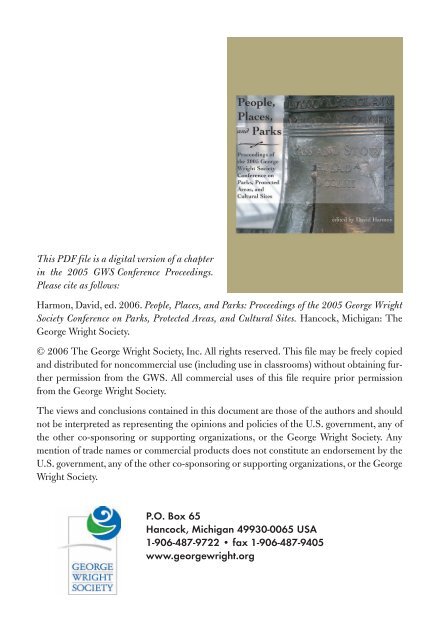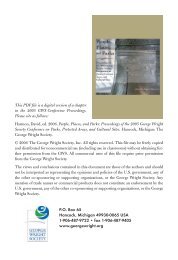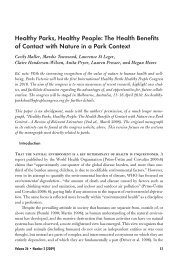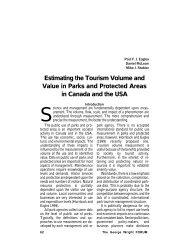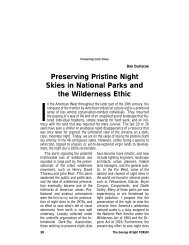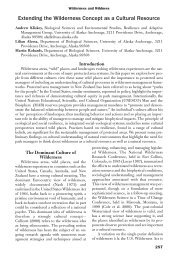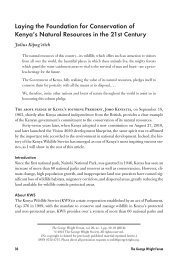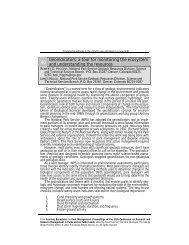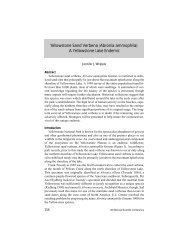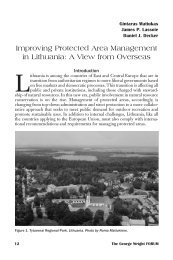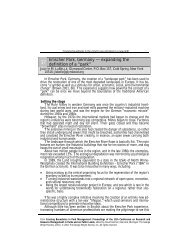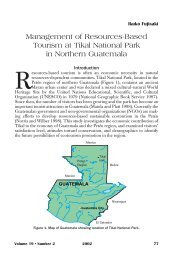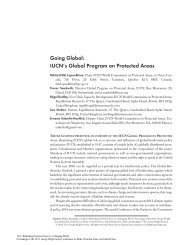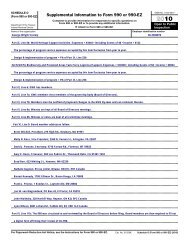Big Egg Marsh Experimental Restoration in Jamaica Bay
Big Egg Marsh Experimental Restoration in Jamaica Bay
Big Egg Marsh Experimental Restoration in Jamaica Bay
Create successful ePaper yourself
Turn your PDF publications into a flip-book with our unique Google optimized e-Paper software.
This PDF file is a digital version of a chapter<br />
<strong>in</strong> the 2005 GWS Conference Proceed<strong>in</strong>gs.<br />
Please cite as follows:<br />
Harmon, David, ed. 2006. People, Places, and Parks: Proceed<strong>in</strong>gs of the 2005 George Wright<br />
Society Conference on Parks, Protected Areas, and Cultural Sites. Hancock, Michigan: The<br />
George Wright Society.<br />
© 2006 The George Wright Society, Inc. All rights reserved. This file may be freely copied<br />
and distributed for noncommercial use (<strong>in</strong>clud<strong>in</strong>g use <strong>in</strong> classrooms) without obta<strong>in</strong><strong>in</strong>g further<br />
permission from the GWS. All commercial uses of this file require prior permission<br />
from the George Wright Society.<br />
The views and conclusions conta<strong>in</strong>ed <strong>in</strong> this document are those of the authors and should<br />
not be <strong>in</strong>terpreted as represent<strong>in</strong>g the op<strong>in</strong>ions and policies of the U.S. government, any of<br />
the other co-sponsor<strong>in</strong>g or support<strong>in</strong>g organizations, or the George Wright Society. Any<br />
mention of trade names or commercial products does not constitute an endorsement by the<br />
U.S. government, any of the other co-sponsor<strong>in</strong>g or support<strong>in</strong>g organizations, or the George<br />
Wright Society.<br />
P.O. Box 65<br />
Hancock, Michigan 49930-0065 USA<br />
1-906-487-9722 • fax 1-906-487-9405<br />
www.georgewright.org
<strong>Big</strong> <strong>Egg</strong> <strong>Marsh</strong> <strong>Experimental</strong> <strong>Restoration</strong> <strong>in</strong> <strong>Jamaica</strong> <strong>Bay</strong>,<br />
New York<br />
George W. Frame, Division of Natural Resources, Gateway National Recreation Area, 210<br />
New York Avenue, Staten Island, New York 10305-5019; george_frame@nps.gov<br />
M. Kathryn Mellander, Division of Natural Resources, Gateway National Recreation Area,<br />
210 New York Avenue, Staten Island, New York 10305-5019<br />
Douglas A. Adamo, Division of Natural Resources, Gateway National Recreation Area, 210<br />
New York Avenue, Staten Island, New York 10305-5019<br />
Saltmarsh loss <strong>in</strong> an urban national park<br />
At <strong>Jamaica</strong> <strong>Bay</strong>, <strong>in</strong> the New York City harbor area, centuries of urbanization destroyed<br />
90% of the wetlands. The rema<strong>in</strong><strong>in</strong>g 400 ha of saltmarsh islands are disappear<strong>in</strong>g at an accelerat<strong>in</strong>g<br />
rate. Currently, about 16 to 20 ha of saltmarsh islands are be<strong>in</strong>g lost every year,<br />
through <strong>in</strong>ternal decay and erosion (Gateway National Recreation Area 2001). The grassy<br />
<strong>in</strong>teriors of the islands are transform<strong>in</strong>g <strong>in</strong>to mosaics of soft mud and isolated grass tussocks.<br />
Investigations are underway to identify the causes of these losses and to f<strong>in</strong>d effective ways<br />
of restor<strong>in</strong>g saltmarshes (Gateway National Recreation Area 2004).<br />
To address the question of what is an effective and long-last<strong>in</strong>g method for saltmarsh<br />
restoration, Gateway National Recreation Area undertook the <strong>Big</strong> <strong>Egg</strong> <strong>Marsh</strong> experimental<br />
restoration. The project area comprises approximately 1 ha of restored saltmarsh and an<br />
adjacent 1 ha of control (or reference) marsh <strong>in</strong> the southern side of <strong>Jamaica</strong> <strong>Bay</strong>. This site<br />
was selected because the saltmarsh is well along <strong>in</strong> transform<strong>in</strong>g to a bare mudflat. It also is<br />
conveniently located adjacent to Broad Channel village, where there is easy access for <strong>in</strong>terpretive<br />
activities and for the public’s participation <strong>in</strong> the Volunteers-<strong>in</strong>-Parks (VIP) program.<br />
The <strong>Big</strong> <strong>Egg</strong> <strong>Marsh</strong> experimental restoration project is funded by the National Park Service,<br />
and is be<strong>in</strong>g carried out by Gateway NRA. The project location, <strong>Jamaica</strong> <strong>Bay</strong>, is at the<br />
southwestern end of Long Island. <strong>Jamaica</strong> <strong>Bay</strong> lies with<strong>in</strong> the boroughs of Brooklyn and<br />
Queens. <strong>Jamaica</strong> <strong>Bay</strong> and its saltmarshes today measure about 6 km north to south, and 13<br />
km east to west. Most of <strong>Jamaica</strong> <strong>Bay</strong>’s estuar<strong>in</strong>e waters, wetlands, and artificial uplands lie<br />
with<strong>in</strong> the <strong>Jamaica</strong> <strong>Bay</strong> Wildlife Refuge, now <strong>in</strong>cluded with<strong>in</strong> the national recreation area.<br />
Gateway was established as the nation’s first urban national park over three decades ago<br />
(U.S. Congress 1972). The park <strong>in</strong>cludes historic forts that defended New York harbor. It<br />
also <strong>in</strong>cludes natural resources that are important habitats for migratory birds and fishes.<br />
Several federal-listed threatened and endangered birds and plants occur with<strong>in</strong> Gateway.<br />
The New York portion of the park <strong>in</strong>cludes most of <strong>Jamaica</strong> <strong>Bay</strong>, large portions of the Rockaway<br />
barrier island, and parts of Staten Island. In New Jersey, most of Sandy Hook barrier<br />
island is <strong>in</strong>cluded <strong>in</strong> the park. Overall, Gateway <strong>in</strong>cludes over 10,500 ha of ocean water, saltmarshes,<br />
beaches, and adjacent uplands. Most of the fr<strong>in</strong>g<strong>in</strong>g freshwater wetlands, however,<br />
are lost to urban development.<br />
Plann<strong>in</strong>g the experimental restoration<br />
An environmental assessment was prepared to recapitulate the issues, present alterna-<br />
The 2005 George Wright Society Conference Proceed<strong>in</strong>gs • 123
tive actions, and review the resources and impacts (Gateway National Recreation Area<br />
2003). The “no action” alternative would allow the gradual transformation of the remnant<br />
saltmarsh <strong>in</strong>to bare mudflats. Six “action” alternatives were considered, but four were immediately<br />
rejected because they were based on barg<strong>in</strong>g <strong>in</strong> sand from a distant source; such<br />
action would have necessitated dredg<strong>in</strong>g an access channel, which was prohibitively expensive,<br />
time-consum<strong>in</strong>g, and destructive. The rema<strong>in</strong><strong>in</strong>g two “action” alternatives that were<br />
considered further depended on excavat<strong>in</strong>g sand from a trench <strong>in</strong> the adjacent tidal creek.<br />
One of these alternatives was to dredge a th<strong>in</strong> layer off the entire creek bottom, and the other<br />
was to dredge a deep narrow trench. The latter, the ecologically preferred alternative, was<br />
chosen because it was expected to provide the purest sand for the marsh surface while hav<strong>in</strong>g<br />
the least impacts on the local fauna.<br />
The selected method for apply<strong>in</strong>g sand to the experimental restoration site is by means<br />
of a small barge with a sw<strong>in</strong>g-ladder dredge and a high-pressure spray (Figure 1). The <strong>in</strong>take<br />
end is the sw<strong>in</strong>g ladder, which moves side-to-side across a swath 6.7 m wide with a maximum<br />
depth of 1.8 m. The <strong>in</strong>take pipe has a rotat<strong>in</strong>g cutt<strong>in</strong>g head at its distal end. The slurry<br />
that enters is pumped through a 20-cm diameter pipe, and then reduced to a 10-cm diameter<br />
nozzle that sits 3 m above the stern. The slurry spray is supposed to deliver to a distance<br />
of around 60 m.<br />
This spray technique was chosen because it was expected to be less destructive to the<br />
remnant marsh than conventional dredg<strong>in</strong>g. The plan was to add layers of sand to elevate the<br />
treatment site generally a m<strong>in</strong>imum of 20 cm above the plane of the highest exist<strong>in</strong>g remnant<br />
Figure 1. A sw<strong>in</strong>g-ladder dredge with high-pressure spray extracted 6,000 cu 3 of sand from a trench <strong>in</strong> the adjacent creek and sprayed it over<br />
the surface of <strong>Big</strong> <strong>Egg</strong> <strong>Marsh</strong>.<br />
124 • People, Places, and Parks
tussocks of smooth cordgrass (Spart<strong>in</strong>a alterniflora). Prescribed places with<strong>in</strong> the site were<br />
to receive an additional layer of sand up to 23 cm thick, to atta<strong>in</strong> a maximum elevation of 43<br />
cm above the reference plane. The lowest-ly<strong>in</strong>g mudflats and dra<strong>in</strong>ages (which cut below the<br />
reference plane) were, therefore, to receive up to 100 cm of fill. The design was to place most<br />
of the sand <strong>in</strong> an L-shaped ridge, parallel<strong>in</strong>g a bend <strong>in</strong> the adjacent creek. The total volume<br />
of sand needed was estimated at 5,000 to 6,000 cu m. Sand was to be dredged from a trench<br />
along the deepest part of the creek bottom, and sprayed throughout the fill site. The dredg<strong>in</strong>g<br />
and spray<strong>in</strong>g were planned to start <strong>in</strong> summer 2003, immediately after the environmental<br />
compliance was completed.<br />
The f<strong>in</strong>ished fill elevation was designed so that most of the marsh would be covered by<br />
the daily high tide. The highest parts of the filled site are the same elevation as the lower edge<br />
of nearby common reed (Phragmites australis). If the fill were any higher, the treatment<br />
marsh would be at risk of <strong>in</strong>vasion by the unwanted alien genotype of common reed.<br />
Ecological Monitor<strong>in</strong>g<br />
Before beg<strong>in</strong>n<strong>in</strong>g the restoration, one year of ecological monitor<strong>in</strong>g was done. It was<br />
accomplished collaboratively through a cooperative agreement between the National Park<br />
Service (NPS) and the Aquatic Resources and Environmental Assessment Center (AREAC)<br />
at Brooklyn College, City University of New York. Coord<strong>in</strong>ation and carry<strong>in</strong>g out the fieldwork<br />
was done by Gateway natural resources staff, assisted by AREAC student <strong>in</strong>terns and<br />
by volunteers (local and <strong>in</strong>ternational). Technical supervision and support were provided<br />
through the NPS Cooperative Ecosystem Studies Unit at the University of Rhode Island,<br />
and through the NPS Boston Support Office.<br />
Monitor<strong>in</strong>g of the control site and treatment site began <strong>in</strong> autumn 2002, one year before<br />
the sand was applied—thus, we have comparisons of the control and treatment sites both<br />
before and after. Monitor<strong>in</strong>g is focused on physical and chemical changes of the marsh surface<br />
and creek bottom, changes <strong>in</strong> plant cover, and changes <strong>in</strong> animal occurrence. Each site<br />
has three surface elevation tables (SETs), more than 100 grid markers (many with elevations),<br />
and 30 permanent 1-m 2 vegetation plots. Also, on the treatment site there are sixteen<br />
2-m 2 unplanted plots to monitor regrowth of the orig<strong>in</strong>al vegetation and colonization by<br />
seedl<strong>in</strong>gs. There are ten places on each site where the water table is monitored, and where<br />
soil particle size and sulfides are monitored. The occurrence of birds, mammals, <strong>in</strong>sects, and<br />
spiders are surveyed, as are the macro<strong>in</strong>vertebrates <strong>in</strong> the soil and water. Water quality (12<br />
parameters) and fishes are sampled <strong>in</strong> the adjacent creek. Recovery of the excavated trenches<br />
that supplied the sand is be<strong>in</strong>g monitored, too. The monitor<strong>in</strong>g <strong>in</strong> large part follows the<br />
guidel<strong>in</strong>es specific to saltmarshes elsewhere (e.g. Niedowski 2000; Raposa et al. 2001;<br />
Roman et al. 2001).<br />
A SET is <strong>in</strong>stalled at three locations <strong>in</strong> the treatment site and another three <strong>in</strong> the control<br />
site. Each SET consists of a steel rod driven at least 15 m deep <strong>in</strong>to the marsh; the rod<br />
is capped with a movable arm that holds n<strong>in</strong>e sampl<strong>in</strong>g p<strong>in</strong>s (Cahoon et al. 2000). Plots of<br />
either sand or bentonite are placed nearby. The SETs provide <strong>in</strong>formation on subsidence,<br />
upward expansion, erosion, and accretion. Before-and-after and control-and-treatment mon-<br />
The 2005 George Wright Society Conference Proceed<strong>in</strong>gs • 125
itor<strong>in</strong>g was accomplished by <strong>in</strong>stall<strong>in</strong>g SETs <strong>in</strong> the treatment site and <strong>in</strong> the control site, with<br />
read<strong>in</strong>gs beg<strong>in</strong>n<strong>in</strong>g one year before the dredg<strong>in</strong>g and cont<strong>in</strong>u<strong>in</strong>g <strong>in</strong>def<strong>in</strong>itely thereafter.<br />
Do<strong>in</strong>g the experimental restoration<br />
Before dredg<strong>in</strong>g and spray<strong>in</strong>g sand on the marsh, a silt fence was <strong>in</strong>stalled around the<br />
low-ly<strong>in</strong>g portions of the perimeter. About 240 hay bales, held <strong>in</strong> place by more than 1,000<br />
wooden stakes and 2,000 m of sisal tw<strong>in</strong>e, provided the primary conta<strong>in</strong>ment (Figure 2).<br />
Where silt runoff became apparent, supplemental conta<strong>in</strong>ment was provided by <strong>in</strong>stall<strong>in</strong>g<br />
100 m of black plastic construction fence for silt control.<br />
The sw<strong>in</strong>g-ladder dredge with high-pressure spray was contracted to pump for 200<br />
hours. Dur<strong>in</strong>g this time, over 6,000 cu 3<br />
of sand were placed on the 1-ha treatment<br />
site. The spray was effectively<br />
delivered to a distance of only 40 m. To<br />
ga<strong>in</strong> additional distance, some slurry was<br />
streamed farther <strong>in</strong>to the marsh <strong>in</strong>terior<br />
by direct<strong>in</strong>g the nozzle horizontally<br />
across the surface of the fresh fill, caus<strong>in</strong>g<br />
the slurry to flow further <strong>in</strong>land. The<br />
placement of the fill was guided by white<br />
polyv<strong>in</strong>ylchloride (PVC) pipes arranged<br />
<strong>in</strong> a grid pattern. Each pipe conta<strong>in</strong>ed an<br />
elevation target marked with red duct<br />
tape and plastic flagg<strong>in</strong>g. Dredg<strong>in</strong>g was<br />
completed by the beg<strong>in</strong>n<strong>in</strong>g of October<br />
2003.<br />
Plant<strong>in</strong>g began on 3 October of that year. Over 20,000 peat pots of smooth cordgrass<br />
were planted by the volunteers and by park staff. These plants were grown on contract with<br />
the Native Plant Center, which is operated by the New York City Department of Parks &<br />
Recreation. Their seed sources were two locations on Staten Island, about 10–30 km from<br />
<strong>Jamaica</strong> <strong>Bay</strong>, but with<strong>in</strong> the New York City harbor. Volunteers cont<strong>in</strong>ued the plant<strong>in</strong>g for<br />
about six weeks, end<strong>in</strong>g <strong>in</strong> late November 2003.<br />
Simultaneously with the plant<strong>in</strong>g, green plastic fence was erected to keep geese from<br />
devour<strong>in</strong>g the new plants. Geese regularly dig out smooth cordgrass by the roots dur<strong>in</strong>g the<br />
w<strong>in</strong>ter, and graze the fresh green growth throughout the grow<strong>in</strong>g season. To prevent this on<br />
the restoration site, volunteers and NPS staff <strong>in</strong>stalled about 700 m of fence on 260 wooden<br />
posts. The fences were arranged <strong>in</strong> cells of about 20 m diameter, to make it difficult for geese<br />
to land or take off with<strong>in</strong> the fences. Additionally, mason’s woven str<strong>in</strong>g with surveyor’s plastic<br />
flagg<strong>in</strong>g were stretched overhead to further subdivide the cells. Repairs had to be done<br />
repeatedly dur<strong>in</strong>g the w<strong>in</strong>ter, due to damage from float<strong>in</strong>g debris (wrack, wood debris, and<br />
ice), w<strong>in</strong>d, and waves.<br />
Results<br />
The U.S. Geological Survey is read<strong>in</strong>g the SETs at approximately three-month <strong>in</strong>ter-<br />
126 • People, Places, and Parks<br />
Figure 2. Before spray<strong>in</strong>g sand on the <strong>Big</strong> <strong>Egg</strong> <strong>Marsh</strong> restoration site,<br />
240 hay bales were staked across the dra<strong>in</strong>ages to conta<strong>in</strong> the runoff of<br />
silt and organics.
vals. On the restoration site their SETs recorded dredge-filled sand 40 to 50 cm thick. In the<br />
year s<strong>in</strong>ce placement of the sand, the ground surface at the SETs fell by several centimeters<br />
due to settl<strong>in</strong>g and surface erosion. The northwest edge of the filled area was impacted by<br />
w<strong>in</strong>d-driven waves, result<strong>in</strong>g <strong>in</strong> an erosion belt 60 m long by 3–5 m wide that lost 20–40 cm<br />
of elevation. Another place of long-fetch is <strong>in</strong> the southeast, where erod<strong>in</strong>g waves created<br />
another erosion belt 20 m long by 5 m wide that lost at least 20 cm of elevation.<br />
In the first spr<strong>in</strong>g after plant<strong>in</strong>g, the smooth cordgrass <strong>in</strong> peat pots, spaced 50 cm apart,<br />
showed nearly 100% survival and regrowth. The only significant mortality of potted plants<br />
was from erosion along the marsh edge, where pots washed away. Plastic fenc<strong>in</strong>g kept the<br />
geese out of the planted area dur<strong>in</strong>g spr<strong>in</strong>g and summer 2004, but s<strong>in</strong>ce then the geese have<br />
become an ever-<strong>in</strong>creas<strong>in</strong>g problem. They seem habituated to the fences, and at high tide<br />
they swim freely through breaks <strong>in</strong> the fences to feed. Snow geese (Chen caerulescens), brants<br />
(Branta bernicla), and Canada geese (Branta canadensis) graze upon and dig out the<br />
smooth cordgrass. The migratory snow geese were present only dur<strong>in</strong>g February and March,<br />
and the brants from October to May. Canada geese, however, were present all year round.<br />
Most of the treatment marsh also experienced germ<strong>in</strong>ation of smooth cordgrass seeds,<br />
which washed naturally onto the sandy surface dur<strong>in</strong>g the w<strong>in</strong>ter. Dur<strong>in</strong>g the last week <strong>in</strong><br />
March 2004, there seemed to be more than 2,000,000 seedl<strong>in</strong>gs on the treatment site. By 20<br />
April, there were still at least 300,000 seedl<strong>in</strong>gs on the treatment site; <strong>in</strong> some places, particularly<br />
<strong>in</strong> wet depressions, seedl<strong>in</strong>g density was up to 800 seedl<strong>in</strong>gs/m 2 . These seedl<strong>in</strong>gs filled<br />
<strong>in</strong> the spaces between the potted plants, at an average density of 35 seedl<strong>in</strong>gs/m 2 surviv<strong>in</strong>g <strong>in</strong><br />
June 2004 (the range was 1 seedl<strong>in</strong>g/m 2 to 230 seedl<strong>in</strong>gs/m 2 ) <strong>in</strong> the plots that were unplanted.<br />
By September, the periphery of the treatment site outside the goose-exclud<strong>in</strong>g fence was<br />
nearly 100% reworked by the geese, result<strong>in</strong>g <strong>in</strong> the loss of most plants (both the potted<br />
plants and the seedl<strong>in</strong>gs that germ<strong>in</strong>ated on site). Inside the fence, however, most plants were<br />
surviv<strong>in</strong>g, except where <strong>in</strong> May and June 2004, hundreds of horseshoe crabs (Limulus<br />
polyphemus) passed under the fences and laid eggs <strong>in</strong> the sand of the restoration site. In<br />
do<strong>in</strong>g so, they dislodged many thousands of t<strong>in</strong>y seedl<strong>in</strong>gs.<br />
One of the expected advantages of th<strong>in</strong>-layer spray was that the orig<strong>in</strong>al scattered<br />
clumps of smooth cordgrass would rebound and cont<strong>in</strong>ue grow<strong>in</strong>g through the th<strong>in</strong> layer of<br />
sand. In the first year after the treatment, however, we observed that the smooth cordgrass<br />
survived only when it received 20 cm or less of sand cover. The th<strong>in</strong>ner the layer, the greater<br />
the survival.<br />
The treatment marsh after one full grow<strong>in</strong>g season had silt accumulat<strong>in</strong>g on the sand.<br />
All but the highest places had a cover of algae. The grass was entirely smooth cordgrass (Figure<br />
3). By October 2004, <strong>in</strong> most of the permanent vegetation plots the stems from seedl<strong>in</strong>gs<br />
were no longer dist<strong>in</strong>guishable from the stems that arose from rhizomes of the potted<br />
plants—their comb<strong>in</strong>ed density averaged 151 stems/m 2 , with a maximum of nearly 600<br />
stems/sq m. The average stem density was nearly double that of the pretreatment plots and<br />
the control plots, due to more of the treatment plots hav<strong>in</strong>g vegetation <strong>in</strong> them, i.e., there<br />
were fewer bare areas after restoration. The restored marsh already was be<strong>in</strong>g colonized by<br />
fiddler crabs (Uca sp.), eastern mud nassa (Ilyanassa obsoleta), common periw<strong>in</strong>kle (Littor<strong>in</strong>a<br />
littorea), as well as fishes, worms, and <strong>in</strong>sects.<br />
The 2005 George Wright Society Conference Proceed<strong>in</strong>gs • 127
Figure 3. By the end of the first grow<strong>in</strong>g season,<br />
<strong>Big</strong> <strong>Egg</strong> <strong>Marsh</strong> rega<strong>in</strong>ed a good carpet of<br />
smooth cordgrass (Spart<strong>in</strong>a alterniflora). The<br />
sandy soil already was accumulat<strong>in</strong>g silt,<br />
algae, and macro<strong>in</strong>vertebrates.<br />
Stakeholder participation<br />
The <strong>Big</strong> <strong>Egg</strong> <strong>Marsh</strong> experimental<br />
restoration is a collaborative<br />
effort that <strong>in</strong>cludes<br />
NPS permanent staff at Gateway<br />
and from the Cooperative<br />
Ecosystem Studies Unit at the<br />
University of Rhode Island.<br />
Other collaborators are AREAC, the Mar<strong>in</strong>e Sciences Institute at Rutgers University,<br />
Department of Oceanography and Mar<strong>in</strong>e Sciences at Dowl<strong>in</strong>g College, U.S. Geological<br />
Survey, Environmental Protection Agency, Natural Resources Conservation Service, New<br />
York State Department of Environmental Conservation, New York City Department of Parks<br />
& Recreation, and three contractors.<br />
NPS’s <strong>Jamaica</strong> <strong>Bay</strong> Institute is located at Floyd Bennett Field, a historic airfield at the<br />
west side of <strong>Jamaica</strong> <strong>Bay</strong>. The <strong>in</strong>stitute’s mission is to lead the way toward improved stewardship<br />
of the <strong>Jamaica</strong> <strong>Bay</strong> ecosystem by creat<strong>in</strong>g a bridge between science and decisionmak<strong>in</strong>g<br />
through research and education on the natural and cultural heritages of <strong>Jamaica</strong> <strong>Bay</strong>.<br />
The <strong>in</strong>stitute endeavors to connect people with the environmental consequences of their<br />
actions. Dur<strong>in</strong>g the past three years, the <strong>Jamaica</strong> <strong>Bay</strong> Institute has dissem<strong>in</strong>ated research<br />
results through publications and workshops, assisted new researchers, and fostered appreciation<br />
and accountability for the <strong>Jamaica</strong> <strong>Bay</strong> ecosystem <strong>in</strong> the urban community. The <strong>in</strong>stitute<br />
is participat<strong>in</strong>g <strong>in</strong> the experimental restoration of <strong>Big</strong> <strong>Egg</strong> <strong>Marsh</strong>.<br />
In 2002–2003, more than 80 volunteers from local community groups, universities, and<br />
government agencies assisted <strong>in</strong> the pretreatment monitor<strong>in</strong>g, site preparation, and plant<strong>in</strong>g<br />
(Figure 4). S<strong>in</strong>ce then, an additional 60-plus volunteers assisted with the ma<strong>in</strong>tenance and<br />
monitor<strong>in</strong>g of the site. Overall, the participants <strong>in</strong> the <strong>Big</strong> <strong>Egg</strong> <strong>Marsh</strong> experimental restoration<br />
number over 200 <strong>in</strong>dividuals, compris<strong>in</strong>g volunteers, student <strong>in</strong>terns, collaborators<br />
from government agencies, contractors, and NPS staff. Many of the volunteers came from<br />
local conservation groups such as the EcoWatchers, the American Littoral Society, the<br />
Audubon Society, and the <strong>Jamaica</strong> <strong>Bay</strong> Task Force. Others came from local bus<strong>in</strong>esses, colleges,<br />
schools, and community organizations. To all these stakeholders, we owe many thanks.<br />
Conclusions<br />
The <strong>Big</strong> <strong>Egg</strong> <strong>Marsh</strong> experimental restoration is technically successful <strong>in</strong>sofar as the sand<br />
is transform<strong>in</strong>g <strong>in</strong>to a silty and organic saltmarsh soil, there is a dense cover of smooth cordgrass,<br />
and an appropriate animal community is becom<strong>in</strong>g established on the treatment site.<br />
Geese graz<strong>in</strong>g and root<strong>in</strong>g <strong>in</strong>creased <strong>in</strong> <strong>in</strong>tensity <strong>in</strong>side the fenced treatment site after the first<br />
128 • People, Places, and Parks
Figure 4. Approximately 80 stakeholders<br />
volunteered <strong>in</strong><br />
2002–2003 to prepare the <strong>Big</strong><br />
<strong>Egg</strong> <strong>Marsh</strong> restoration site,<br />
replant the Smooth Cordgrass,<br />
and assist with the monitor<strong>in</strong>g.<br />
S<strong>in</strong>ce then, additional volunteers<br />
and other stakeholders br<strong>in</strong>g the<br />
total to 200 participants.<br />
ten months, apparently due to habituation. Consequently the goose-deterr<strong>in</strong>g fence will need<br />
to be rigorously ma<strong>in</strong>ta<strong>in</strong>ed <strong>in</strong> place for an additional year, or alternative goose-scar<strong>in</strong>g methods<br />
will be needed. Although the results are good to date, it rema<strong>in</strong>s to be seen how many<br />
decades the restored site will last.<br />
The experimental restoration also was successful <strong>in</strong> a nontechnical way, by provid<strong>in</strong>g<br />
the opportunity for about 200 local stakeholders to become <strong>in</strong>volved first-hand <strong>in</strong> protect<strong>in</strong>g<br />
wetlands.<br />
Gateway currently is collaborat<strong>in</strong>g with the Army Corps of Eng<strong>in</strong>eers to restore at least<br />
12 ha of saltmarsh at Elder’s Po<strong>in</strong>t, <strong>in</strong> the north side of <strong>Jamaica</strong> <strong>Bay</strong>. The f<strong>in</strong>d<strong>in</strong>gs from <strong>Big</strong><br />
<strong>Egg</strong> <strong>Marsh</strong> will be useful for design<strong>in</strong>g and monitor<strong>in</strong>g the Elder’s Po<strong>in</strong>t restoration.<br />
References<br />
Cahoon, D.R., P.E. Mar<strong>in</strong>, B.K. Black, and J.C. Lynch. 2000. A method for measur<strong>in</strong>g vertical<br />
accretion, elevation, and compaction of soft, shallow-water sediments. Journal of<br />
Sedimentary Research 70:5, 1250–1253.<br />
Gateway National Recreation Area. 2001. The <strong>Jamaica</strong> <strong>Bay</strong> Blue Ribbon Panel on <strong>Marsh</strong><br />
Loss and Coastal Sea Level Rise: A Future Agenda for Mitigation and Pilot Investigations.<br />
F<strong>in</strong>al Report, July 2001. Staten Island, N.Y.: Gateway National Recreation Area.<br />
———. 2003. Gateway National Recreation Area, <strong>Jamaica</strong> <strong>Bay</strong> Wildlife Refuge, <strong>Big</strong> <strong>Egg</strong><br />
<strong>Marsh</strong> <strong>Restoration</strong> Demonstration Environmental Assessment, May 28, 2003. Staten<br />
Island, N.Y.: Gateway National Recreation Area.<br />
———. 2004. Proceed<strong>in</strong>gs—<strong>Jamaica</strong> <strong>Bay</strong>’s Disappear<strong>in</strong>g <strong>Marsh</strong>es: Highlight<strong>in</strong>g Ongo<strong>in</strong>g<br />
Research, Local and International Perspectives and Future <strong>Restoration</strong> Plans. March 3,<br />
2004, New York Aquarium, Scientific Symposium and Public Forum. Staten Island,<br />
N.Y.: <strong>Jamaica</strong> <strong>Bay</strong> Institute and Gateway National Recreation Area.<br />
Niedowski, N.L. 2000. New York State Salt <strong>Marsh</strong> <strong>Restoration</strong> and Monitor<strong>in</strong>g Guidel<strong>in</strong>es.<br />
Albany and East Setauket, N.Y.: New York State Department of State, Division of<br />
Coastal Resources, and New York State Department of Environmental Conservation,<br />
Division of Fish, Wildlife and Mar<strong>in</strong>e Resources, Bureau of Mar<strong>in</strong>e Resources.<br />
The 2005 George Wright Society Conference Proceed<strong>in</strong>gs • 129
Raposa, K.B., and C.T. Roman. 2001. Monitor<strong>in</strong>g Nekton <strong>in</strong> Shallow Estuar<strong>in</strong>e Habitats: A<br />
Protocol for the Long-term Coastal Ecosystem Monitor<strong>in</strong>g Program at Cape Cod National<br />
Seashore. Wellfleet, Mass.: Cape Cod National Seashore. On-l<strong>in</strong>e at www.nature.nps.gov/im/monitor/protocoldb.cfm.<br />
Roman, C.T., M.-J. James-Pirri, and J.F. Heltshe. 2001. Monitor<strong>in</strong>g Salt <strong>Marsh</strong> Vegetation: A<br />
Protocol for the Long-term Coastal Ecosystem Monitor<strong>in</strong>g Program at Cape Cod National<br />
Seashore. Wellfleet, Mass.: Cape Cod National Seashore. On-l<strong>in</strong>e at www.nature.nps.gov/im/monitor/protocoldb.cfm.<br />
U.S. Congress. 1972. An act to establish the Gateway National Recreation Area <strong>in</strong> the States<br />
of New York and New Jersey, and for other purposes. Public Law 92-592—Oct. 27,<br />
1972 [86 Stat.] Wash<strong>in</strong>gton, D.C.: United States Government Pr<strong>in</strong>t<strong>in</strong>g Office,<br />
1308–1311.<br />
130 • People, Places, and Parks


